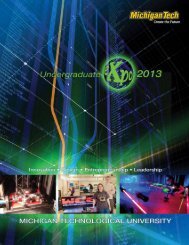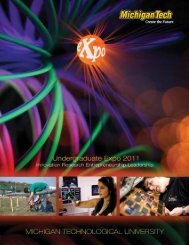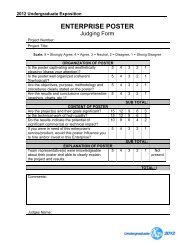Download - Undergraduate Expo - Michigan Technological University
Download - Undergraduate Expo - Michigan Technological University
Download - Undergraduate Expo - Michigan Technological University
You also want an ePaper? Increase the reach of your titles
YUMPU automatically turns print PDFs into web optimized ePapers that Google loves.
Senior Design<br />
116<br />
Pneumatically-Powered Assistive<br />
Exoskeleton<br />
117<br />
Fatigue in Stainless Steel<br />
Components Produced by Powder<br />
Metallurgy and Hot Isostatic<br />
Pressing<br />
118<br />
Split Hopkinson Pressure Bar<br />
Testing setup for the Pneumatic Muscle, pulling a<br />
20-lb weight.<br />
Team Members<br />
Brandon Breda, Zach Carlson, and Carl Seidel,<br />
Electrical Engineering Technology<br />
Advisor<br />
Dr. Aleksandr Sergeyev<br />
Sponsors<br />
MAC Valves, Portage Health<br />
Project Overview<br />
Our goal is to develop an exoskeleton that<br />
reacts more naturally to the user’s movement<br />
by providing structural support—modeled after<br />
kinematic motion of the skeletal system and the<br />
use of soft pneumatic “muscle-like” actuators.<br />
The development of an affordable, adaptable,<br />
lightweight, and user-friendly powered exoskeleton<br />
for lower limb and back support has many<br />
applications in industry.<br />
Anthony Tuthill prepares to load a sample using<br />
the MTS machine.<br />
Team Members<br />
Tyler Botbyl, Samantha Leonard, Dave MacEwen,<br />
and Anthony Tuthill, Materials Science and<br />
Engineering<br />
Advisor<br />
Dr. Calvin White<br />
Sponsor<br />
Electric Power Research Institute (EPRI)<br />
Project Overview<br />
The Electric Power Research Institute (EPRI) is<br />
conducting research to examine the suitability of<br />
replacing traditional cast stainless steels used for<br />
pressure-boundary applications with components<br />
produced by powder metallurgy (PM) and hot<br />
isostatic pressing (HIP). Our team is conducting<br />
low-cycle fatigue and surface-roughness tests on<br />
material obtained from a PM-HIP stainless-steel<br />
prototype valve body, as well as an equivalent cast<br />
stainless steel. A literature search has led to the<br />
development of a plan to explore and analyze the<br />
difference in the process-property-microstructure<br />
relationship between the two components, using a<br />
Six Sigma approach.<br />
Datum for the design of the Split Hopkinson<br />
Pressure Bar project. Datum belongs to the civil<br />
engineering department.<br />
Team Members<br />
Eric Little and Thomas Roose, Mechanical<br />
Engineering Technology; and John Kolacz,<br />
Industrial Technology<br />
Advisor<br />
Scott Wagner<br />
Sponsor<br />
School of Technology<br />
Project Overview<br />
Split Hopkinson Pressure Bar (SHPB) is an<br />
apparatus designed to measure stress-pulse<br />
propagation in a metal bar. Our goal is to create the<br />
mechanical means of a scaled-down version of the<br />
SHPB with design improvements for testing metal<br />
samples. Currently the Department of Civil and<br />
Environmental Engineering at <strong>Michigan</strong> Tech has<br />
a forty-five-foot-long SHPB for testing three-inch<br />
diameter concrete samples.<br />
Senior Design 2012 • 11






